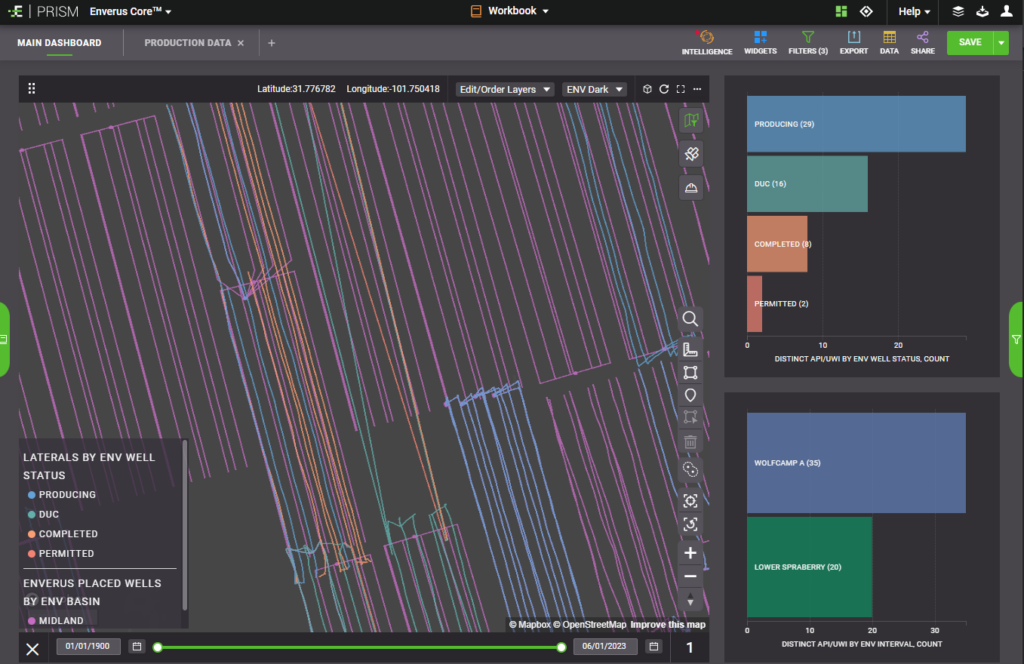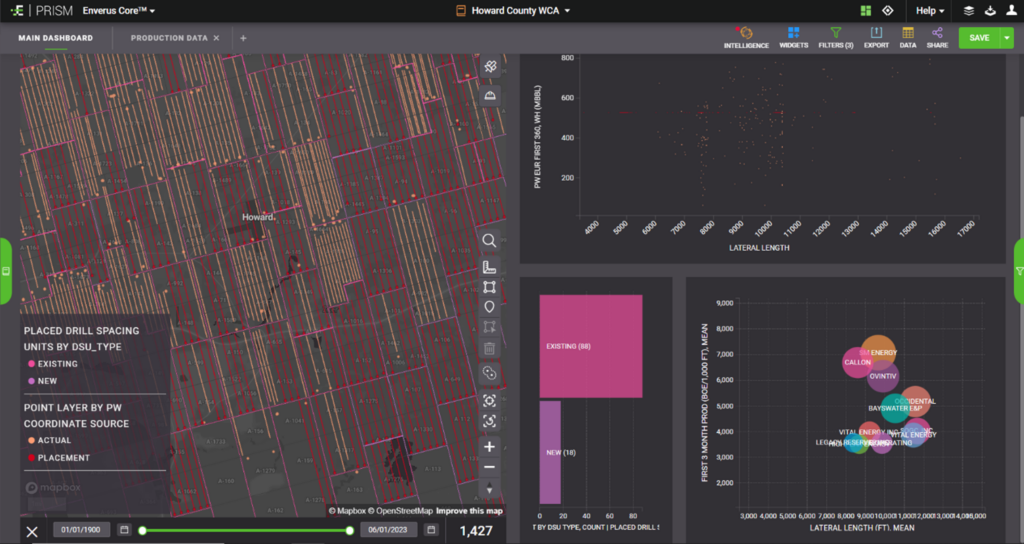Inventory is king in 2023. Operators and investors alike are more concerned than ever about remaining inventory – who has it, where is it, and will it be economic? To answer these questions, most turn to the tried-and-true, but also tedious and time-consuming method of calculating future well locations – acreage math.
Acreage math has long been the industry-standard approach to calculate the future potential development on a given area of interest by engineers and analysts. While it is straightforward, there are pitfalls because development styles and patterns have changed since acreage math was popularized.
Three main factors that cause errors in acreage math calculations are:
- Not considering offset wells and cube style development.
- Geologic complexity can’t be written off with a blanket viability risk factor.
- Acreage orientations and sizes can result in laterals that aren’t placed to optimize the area.
As development styles have changed, so should your approach to calculating inventory. Leveraging technology for speed, and analysts for quality control, Enverus Placed Well Analytics helps to avoid these pitfalls and increase accuracy of remaining inventory evaluations- all in a matter of minutes.
Pitfall 1: Not Accounting for Offset Wells
With the shift to multi-well and cube style development in recent years, acreage math can result in an overestimation of sticks.
Acreage math cannot account for what has already been drilled and lacks the sophistication to distinguish drillable acreage from uneconomic acreage due to well degradation. It lumps all the non-drilled acreage together and assumes that a certain number of wells can be placed into the open space, compounding inventory counts exponentially.
The Solution: Consider existing wells
Enverus Placed Well Analytics places sticks to be offset from existing wells at four or five different spacing scenarios per play. It can also take existing wells into account and ensure there is enough “buffer room” to place sticks around them in a DSU. Sticks will not be placed within 100 ft of the DSU boundary. To ensure that stick counts stay up to date and accurate, existing wells are updated monthly so that any undrilled location that sees drilling activity is converted to an actual well.

Figure 1: Enverus Placed Wells (pink) for the Wolfcamp A and Lower Spraberry in the Midland Basin accounting for producing wells, drilled uncompleted (DUC), Completed well status.
Pitfall 2: Overestimating in Complex Geology
Geologic complexity is often left out of the equation because it can add weeks of work to acreage math to properly risk off. This means that sticks could be placed in zones that are not geologically viable, whether due to reservoir quality or structural features. With acreage math, we commonly see a simple percentage applied to risk off the total, but it doesn’t get specific enough to determine which zone is at risk or what should be avoided.
The Solution: Consider well-level geo properties, spacing, infrastructure and economics together
In calculating inventory with Placed Well Analytics, the user can interact with well level geological properties, while also layering on spatial positioning and economics. It is also important to note nearby activity in case your future inventory plan coincides with an offset neighbor. Not knowing offset activity could cause delays due to shut-in wells. Future inventory tie-ins with existing pipelines and facilities must also be considered in your analysis.
Having all aspects of development in a single view means that instead of applying a blanket risk factor to your calculations, you can clearly define what the future potential development of your AOI could look like – in under an hour. This interactive and dynamic methodology allows for a smooth and transparent workflow when compared to acreage math, which relies on arbitrary risk factors and manual Excel workflows, often losing precision and granularity in the process.

Figure 2: Geologic complexities in the Delaware Basin can contribute a significant amount of risk to future inventory locations which Placed Well Analytics can make understanding that risk faster by having wells tied to geologic properties and geologic grids in one platform while calculating inventory.
Pitfall 3: Not Accounting for Acreage Orientation
Acreage orientation and size can also cause complications in optimizing future locations for certain lateral lengths. It can result in errors or be an extremely manual and time-consuming process to account for.
Acreage math lacks the ability to take the spatial setup into account. It sums up all unused acreage and considers it as “fair game” for development. Inevitably in the process, credit is ascribed to tiny and awkward areas of land that can only fit minimal lateral lengths and will probably never be drilled. This failure to account for correct acreage orientation can inflate remaining inventory counts by up to 50%.
The Solution: Plan based on future development
Placed Well Analytics prevents the inflated stick counts yielded by acreage math by giving a spatially realistic view of what future development will look like. A standardized set of DSUs, crafted by Enverus analysts with basin-specific expertise set the precedent for future well orientation. To reflect realistic development, sticks follow the azimuth trend of these DSUs, and the longest lateral possible is placed at the selected spacing scenario.

Figure 3: Placed Well Analytics accounting for DSU orientations in the Midland Basin – Howard County.
Conclusion
Inventory is the single most important factor going into every company evaluation in 2023. Make sure you are adapting your methods away from acreage math, with its many pitfalls, to model future inventory faster and more accurately.
About Enverus Intelligence®| Research
Enverus Intelligence Research, Inc. is a subsidiary of Enverus and publishes energy-sector research that focuses on the oil and natural gas industries and broader energy topics including publicly traded and privately held oil, gas, midstream and other energy industry companies, basin studies (including characteristics, activity, infrastructure, etc.), commodity pricing forecasts, global macroeconomics and geopolitical matters. Enverus Intelligence Research, Inc. is registered with the U.S. Securities and Exchange Commission as a foreign investment adviser. Click here to learn more.
Cayley Krynowsky
Cayley Krynowsky is a Data Science Product Owner at Enverus where she works to discover industry problems and deliver high value solutions to her clients. Prior to her time at Enverus, she worked at Weatherford Canada as a field engineer in the OFS sector.
Share This:




 CDN NEWS |
CDN NEWS |  US NEWS
US NEWS 



























